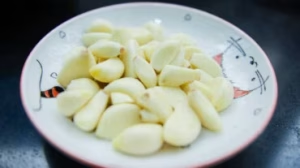
Garlic for Acne: Should it be eaten raw or applied to the skin?
Using garlic for acne has been shown to be a good treatment because it helps unclog pores, reduces sebum production and has protective properties.
In addition to adding flavor to our meals, making them very healthy and delicious, garlic is also good for the skin. It helps unclog pores and reduce blackheads and whiteheads, while also reducing inflammation caused by acne and pimples. But be careful! Garlic can be very damaging to the skin and it is very important to know how to use garlic to care for your skin. Read on to find out why garlic is recommended for acne treatment and how to use it properly.
Can garlic get rid of acne?
Garlic is effective in treating acne because it helps reduce sebum production, clear pores, and reduce the appearance of blackheads and whiteheads.
However, garlic should be used with caution as its ingredients can be very irritating to the skin. A study published in the Avicenna Phytomedicine Journal says that garlic contains substances that help inhibit the growth of bacteria and viruses. Therefore, garlic is good for skin problems.
Another study published in Food Science and Nutrition noted that some compounds in garlic can increase the ability to kill bacteria. One of these substances, allicin, helps kill Streptococcus epidermidis, which is said to be the cause of acne.
Another benefit of using garlic to treat acne is its anti-inflammatory properties. According to food and toxicology studies, allicin found in garlic can reduce cytokine molecules that cause inflammation.

How to use garlic to get rid of acne?
When it comes to using garlic to treat acne, people are divided on whether to consume it raw or as a paste. A Tik Tok video from 2024 showed people eating garlic cloves to reduce acne. However, experts say it’s important to dilute the garlic to avoid skin irritation.
You can crush two cloves of garlic and mix them with juice or milk to make a thin paste and apply it to your face, avoiding sensitive areas like your eyes and mouth. Leave it on for 15-20 minutes and rinse.
Garlic can also be used cosmetically, but it should be diluted with honey or aloe vera gel to avoid irritation. Eating garlic on an empty stomach also has some benefits for the skin.
Can garlic be used to treat acne?
Yes, garlic can also be used to treat acne. Garlic should be used in diluted form. Take two cloves of garlic and mix its juice with honey or aloe vera gel for a gentle treatment. Apply the mixture directly on the acne, let it work for 15-20 minutes, then rinse. This method helps reduce inflammation and prevent scarring during acne treatment.
Precautions when using garlic to treat acne
It is important to be careful not to irritate the skin when using garlic to treat acne:
Always dilute garlic with honey, milk or other soothing medicines and do a test to make sure your skin does not feel bad.
Do not use garlic near sensitive areas such as the eyes, mouth and limit the application time to 15-20 minutes, especially for the first time.
How to choose garlic for acne treatment?
It is best to choose fresh garlic cloves for acne treatment, as they contain high levels of active ingredients such as allicin, which is important in fighting acne. Do not use prepackaged or finished products as these products will reduce the results and may not be effective in treating acne.
How many cloves of garlic can you use per day to treat acne?
When using garlic cream to treat acne, two cloves of garlic are enough to cover the entire face. It is important not to use too much garlic, as using too much can cause skin irritation. The focus is on cosmetics, as there is no evidence that using garlic specifically improves skin clarity.

What are the side effects of using garlic to treat acne?
The main side effects of using garlic to treat acne is skin irritation, especially when used in concentrated forms. Side effects of using garlic to treat acne include:
- Irritant contact dermatitis
- Allergic contact dermatitis
- Protein contact dermatitis
- Allergic reactions to proteins present in plants and animal
- Zosteriform dermatitis (another form of rash)
- Contact urticaria
- A wheat and flare reaction
- Garlic can be caustic, often leading to burns or patchiness if not diluted properly.
